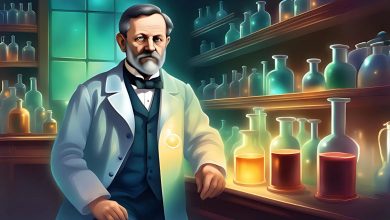Prof. Dr. Hulusi Behçet: Famous Anywhere but Home

“Behçet is a world-renowned scientist, but not in Turkey,” he said, adding: “He always promotes his inventions abroad; that’s why you can’t find him in Turkey.”
– Prof. Philipp Schwartz, German pathologist
In the world of science, there are countless scientists who name their discoveries or inventions after themselves. We’ve all heard these names, Schröndinger’s Equation, Newton’s Laws, and more.
One of these names is Ordinaryus Professor Doctor Hulusi Behçet. (Ordinaryus is a very special title that is awarded to distinguished scientists in the Turkish Academy)
He was born on February 20, 1889, in Istanbul. His surname Behçet comes from his grandfather. Prof. Behçet’s father, who was friends with Mustafa Kemal Atatürk founder of the Republic of Turkey, chose his own father’s name, with special permission during the Surname Law.
After completing his early education at Beirut French School and Beşiktaş High School, Hulusi Behçet graduated from the Military Medical School with the rank of Medical Captain; during the First World War, he worked as an expert on dermatology and sexually transmitted diseases at the Military Hospital in Edirne. He founded the Skin Diseases and Syphilis Clinic, which formed the basis of dermatology in Turkey, within the establishment of Istanbul University in 1933. Behçet is also the first scientist to receive the title of Professor in the Turkish Academy.

He started to treat a patient who came to his clinic between 1924 and 1925. The patient had lost his eyesight as a result of symptoms of an unknown cause which he suffered from for many years. Although Behçet could not reach a definite conclusion, he followed the patient for many years. During this time, he began to follow other patients with similar symptoms. As a result of this follow-up, he published all of his findings in 1936, explaining to the medical world that the symptoms of these patients were caused by a disease that has not yet been defined. The existence of this new disease was accepted by the whole medical world, with the detection of parallel cases with Hulusi Behçet’s publication from various parts of the world during the next two years following this statement. In 1947, on the recommendation of Professor Mischer from the Faculty of Medicine in Zurich, the disease was included in the medical literature as “Morbus Behçet”. Today, the term “Behçet’s Disease” is widely used.
The main cause of Behçet’s Disease still remains a mystery. Although there is no specific factor that triggers the disease, environmental factors, and genetic predisposition cause symptoms. Studies conducted in recent years have revealed that approximately 80% of people with HLA-B5 genetic structure show symptoms of Behçet’s Disease. These symptoms are ulcers formed in the mucous plates, such as oral and genital ulcers, as well as inflammation of the heart and brain vessels. The most common of these types of inflammation is uveitis, which is an inflammation of the eye vessels.

The lack of an accurate diagnosis method also prevents individuals from being diagnosed at the right time. Although the Pathergy Test, which is performed by inserting a sterile needle into a certain area of the skin, and the presence of HLA-B5 indicate the presence of the disease; There are many people who suffer from the symptoms despite their negative test results for Behçet’s Disease.
Behçet’s Disease is more severe in men than in women and goes into a more calm state with increasing age, but unfortunately, it is not yet possible to completely cure the disease. Behçet, which is mostly seen in Turkey and Japan in the world, is also more common in countries located on the Historical Silk Road compared to the rest of the world. Therefore, another name for the disease is ” Silk Road Disease “. In Turkey, 100 to 300 out of every 100,000 people are diagnosed with Behçet’s Disease. However, this figure is thought to be much higher by physicians.

Although it is a disease defined by a physician trained in Turkey, the disease is not well known both by physicians in Turkey and by the public. Rheumatology specialists, who are interested in the diagnosis and treatment of the disease, state that many Behçet’s patients in Turkey receive their diagnosis only after they show severe symptoms, but these patients could continue their lives without getting worse with early diagnosis. Behçet and Familial Mediterranean Fever Patients Association organizes various events on the 20th of February every year in order to raise awareness in Turkey.
Thanks to the disease he described, Hulusi Behçet, who helped many people in the world to be followed and treated systematically, received the title of Ordinaryus* in 1939. Professor Behçet, who died on March 8, 1948, at the age of 59, has 196 publications.
*The title of ordinaryus, which was removed from the Turkish Academy in 1981, has been given to people who have been professors for at least five years and who have achieved great success in their fields. The last person entitled to this title is the lawyer and philosopher Prof. Dr. Reşat Kaynar (1910-2006).
References and Further Reading
Saylan T. Life story of Dr. Hulusi Behcet. Yonsei Med J. 1997 Dec;38(6):327-32. doi: 10.3349/ymj.1997.38.6.327. PMID: 9509901
Behçet’s Disease, Pediatric Rhematology European Society, 2016
Marsh , SGE , Albert , ED , Bodmer , WF , Bontrop , RE , Dupont , B , Erlich , HA , Fernandez-Viña , M , Geraghty , DE , Holdsworth , R , Hurley , CK , Lau , M . Lee , KW , Mach , B , Maiers , M , Mayr , WR , Mueller , CR , Parham , P , Petersdorf , EW , Sasazuki , T , Strominger , JL , Svejgaard , A , Terasaki , PI , Tiercy doi:10.1111/j.1399-0039.2010.01466.x , JM , Trowsdale , J. , 2010. Tissue Antigens 75 , 291–455
Images not cited are used through Canva Pro with a royalty payment.
The proofreading has been done by Asu Pelin Akköse and Mete Esencan.
Would you like to support us?
- For more detailed information, you can check our “Support Us!” page!







